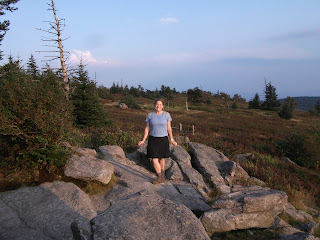I wrote this piece in early 2004.
I wore a skirt because I’ve always enjoyed wearing them:
long ones, short ones, shear ones, jean ones, ones that flutter on the dance
floor. They make me feel like a
woman: powerful, sexy and strong.
After every backpacking trip I can remember, I have rushed home to slip
one on; because in doing so, I reconcile my feminine side with the part of me
that can get dirt under my nails, not shower for a week, and eat food that has
fallen on the ground. That
was the biggest reason I decided to wear a skirt on this epic – ok, six month –
journey from Georgia to Maine on the Appalachian Trail. It would define me as a woman and as an
individual. As I donned my homemade
bright red wrap around skirt, fastened with Velcro at the top, I wanted to
share with the world that a woman can hike 2,000 miles in a skirt. She can do
anything she puts her mind to; she is strong.

I hiked in a skirt – but there was nothing feminine about
it. At times I had mud up to my
knees. My hair was matted so
thickly between my showers in towns that it took 30 minutes of combing to
untangle and lay flat the locks. I
smelled; my belongings smelled. My
wallet was a plastic bag. My
“umbrella,” a garbage bag.
Typifying my outdoor living was this skirt that had become a darker shade
of red on the back from ground-in dirt and sweat, the front was faded from
exposure to the sun. Nothing says
well-worn like a two-toned article of clothing.
 |
| Here we are turning compost as our work-for-stay duty at Lake of the Clouds Hut. |
Hiking in a skirt wasn’t always pretty. I left some of my behind on a rockface
in Maine because my sneaker slipped from the foot hold immediately calling to
question my shimmy-down-the-rock method; shorts may have ripped but my butt
would have been safe. I crossed
Franconia Ridge in my wrap in such high winds that every attempt to lift a leg
and place it in front of me resulted in my leg being two feet to the
right. Needless to say, I showed
at least half of New Hampshire my zebra print undies that day, and left an
indelible memory in the minds of my hiking partners. Sometimes, I even got a hurtful comment or two from
comrades. Some male hikers,
perhaps threatened by my hiking ability or caught in their generational frame
of mind, made comments about “chasing the skirt,” as I was passed them on the
trail. I still waiver on the
question their ignorance, insensitivity or attempt at humor.

But, it had its perks, like peeing standing up and with my
pack on. Now this may seem silly,
but I drank a lot of water - over a gallon a day - so the call to nature was
frequent and cumulatively time consuming. For the first 600 miles of this trip,
and every hiking trip before, I would unfasten my hipbelt, set my pack down,
and take out my toilet paper and the plastic bag for disposing the used
paper. I’d find a nice place to
pee, then work everything in reverse: putting the toilet paper away, hoisting
the pack back on, and fastening my hipbelt before moving forward. Discovering I could pee standing up,
grab a couple of accessible and nonpoisonous leaves with which to wipe, cut my
pee stop times in half and made me a more efficient hiker.
I got a lot of odd looks from people, and was asked to
explain myself through that squinted eyeball of scrutiny as someone looked from
my mud covered boots, up my sinewy legs, to the skirt, the backpack, nostrils
flared as they caught the smell, and the inquiry began: “You hike in that?” This question came from hikers and
non-hikers alike. After explaining
the benefits of comfort, freedom of movement and discretion when dressing in
shelters or hostels, people seemed to get it. For female hikers bewildered by my chafe-free claim, I
shared my secret weapon: BodyGlide, a body lubricant used by runners, which I
applied ritualistically each morning.
The ability to pee standing up was received with much enthusiasm, and
was the turning point for many of them to make the switch.
 |
The Lemon Squeezer in New York.
Pack goes through first.
|
I wasn’t the only woman on the trail, but what I found was
that I became a spokesperson for women on the trail, perhaps because of my
chosen attire. I answered all
kinds of questions: “Yes, I’m hiking alone,” “No, I’ve never felt threatened by
anyone on the trail,” or “I’ve seen bears, but they are more interested in
blueberries than me; I’ve avoided the snakes by giving them plenty of room;
and, generally, shelters are home to at least one spunky mouse.”
As my journey evolved, so did I. Initially, I may have been a woman hiking the trail, but for
the last 1,000 miles, I was a hiker hiking the trail. I knew that for every challenge that I faced, others faced
it, too. I set out to prove that women
could hike the trail in a skirt, and so they can, but not all women will. Not all men will either. It is fortitude of mind and soul. It is the individual journey that takes
us places. What we choose to wear
is insubstantial.
As for that two-toned red skirt - it is the best skirt I’ve
ever worn, and it is safely quarantined to a plastic underbed box where its
putrid smell and vivid memories are nestled until my next adventure.
(This article ran in the June 2004 issue of Blue Ridge Outdoors and was performed as a monologue of women's stories presented by Phoenix Theater Company in Washington D.C. in the fall of 2004.)



















